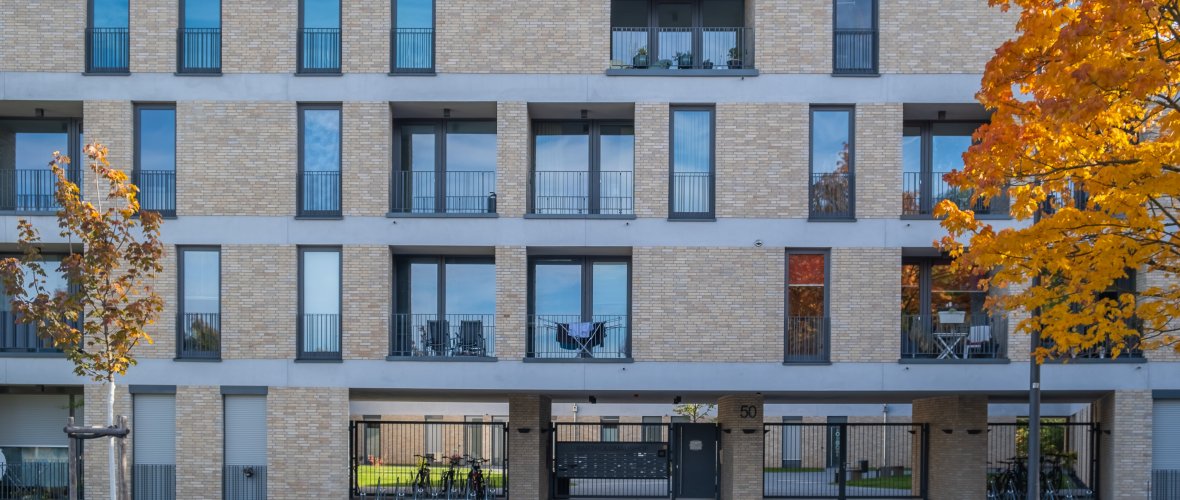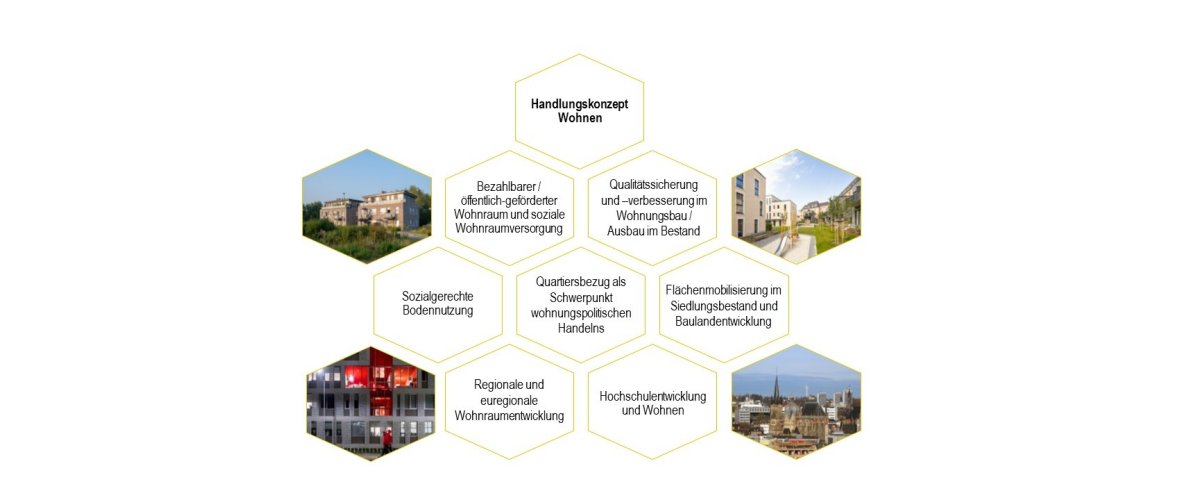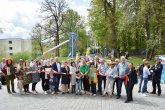Over 260,000 people live in Aachen. Different needs and life situations come together here - whether you live in a single household, with your family, in a shared flat or in a communal housing project.

Creating affordable and needs-based housing for people in all walks of life is a key challenge in the city of Aachen and is a particular focus of policy and administrative action. Aachen's housing market is characterized by a number of dynamic developments and challenges. The local supply and demand situation is shaped by a population that has grown continuously over the years, declining land resources and rising prices for rental and owner-occupied properties.
Living from A - Z
Our online encyclopedia on housing from A to Z gives you an overview of all services and topics relating to housing in the Housing, Social Affairs and Integration department.
Application for misappropriation in privately financed housing
Since August 1, 2019, the use of residential space for purposes other than residential purposes and the vacancy of residential space in the city of Aachen has been subject to approval.
A misappropriation of residential space exists, for example, in the case of commercial room rentals for tourist purposes or furnished accommodation for a period of less than three months. The use or conversion of residential space into commercial or office units also constitutes misappropriation in accordance with the Housing Protection Ordinance. In addition, residential space is also considered to be misappropriated through avoidable vacancy or demolition.
Click here for the application form.
Building and living in community
The Coordination Office for Community Building and Housing is the central point of contact for anyone who wants to set up a community housing project or join an initiative.
Advice on municipal housing promotion
The aim of housing promotion is to create housing for people who cannot adequately provide for themselves on the market or to adapt existing housing to the requirements of demographic change and to upgrade its energy efficiency.
In addition, qualitative requirements are placed on the living space that are tailored to the respective needs of the groups of people (families, households with children, pregnant women, older people and people with disabilities, students).
Contact:
Are you interested in housing promotion and need individual advice? Then make an appointment:
Tel.: 0241 / 432-56308
Mail: wohnraumfoerderung@mail.aachen.de
Free registration of subsidized housing online
As the authorized person (owner, administration) of a publicly funded apartment, you are obliged to notify the Department of Housing, Social Affairs and Integration promptly of any vacant or vacated apartment.
Exemptions for subsidized apartments
In order to be able to move into a subsidized apartment, a suitable and valid certificate of eligibility for housing or a certificate of entitlement is required.
Integrated neighborhood development
Housing creation as a challenge and neighborhood development, taking into account the local social structure, must be conceptually interlinked
, as housing projects have a significant and, above all, long-term influence on the local social structures of the city. Conversely, looking at neighborhoods and local population compositions, for example, enables the successful and needs-based implementation of housing projects in the local environment.
The current projects in integrated neighborhood development can be found further down the page.
Housing action plan
The housing action plan is a strategic and implementation-oriented analysis and planning instrument that serves to analyze local development processes and, on this basis, to develop future-oriented strategies and measures for the local housing market.
The fields of action and measures for the housing action plan can also be found further down the page.
Report vacancies in Aachen online
The protection of living space is a high priority in Aachen. The optimal use of existing properties is particularly important so that housing can be guaranteed at reasonable conditions for everyone. For this reason, the statutes for the protection and preservation of residential space in Aachen, as amended by the first addendum dated August 29, 2023, have been in force since August 2, 2019. According to these statutes, it is generally not permitted to use residential space for purposes other than housing without prior approval. This also includes leaving residential space vacant, as every vacant apartment represents a valuable and urgently needed resource for providing the Aachen population with housing.
Now all citizens have the opportunity to simply report vacancies online - anonymously if they wish.
Owners and landlords who are obliged to report vacancies of more than six months under the above-mentioned statutes can now do so using the online service "Notification of residential vacancies".
You can access the vacancy report here.
Concept allocation of urban properties
When marketing more than 10 adjoining terraced house plots and for multi-storey residential construction projects on which a total of more than 15 residential units can be built, the possibility of a concept award is to be examined and submitted to the Housing and Real Estate Committee
property-related evaluation criteria for a decision (resolution of 11.09.2018).
In concept procedures, the focus is on the quality of the submitted concept; the purchase price plays a
minor role in the weighting of the award criteria. Concept awards can be carried out with fixed prices (market value) or a best bid procedure is used, in which the
price competition is also taken into account. This best-bid procedure is therefore a concept award procedure in which the price is taken into account.
The concept award results in a reduction in the purchase price and thus costs, which should benefit the quality of housing construction.
The aim of the concept award is to attract different players (e.g. building groups and cooperatives) for housing development
and to integrate them into the neighborhood or site development.
The objectives include the development of lively, social, urban and architecturally attractive and sustainable projects as well as attracting new players to Aachen's housing market. The quality of the submitted concept, and not the budgetary income, is the focus of the award decision.
You can view the procedure here.
Notification of misappropriation of privately financed housing
If you suspect misappropriation or know of misappropriated living space, you can report this to us using the online form below, even without providing personal data. Please also note the supplementary information material.
Since August 1, 2019, the use of residential space for purposes other than residential purposes and the vacancy of residential space in the city of Aachen has been subject to approval.
Click here to report a misappropriation.
mitgeDACHt funding program
Affordable housing is becoming increasingly scarce. Aachen's housing market is also affected by this development. In particular, there is a lack of affordable housing for older people, students and families (see housing market report). With the aim of making optimal use of possible redensification potential in the urban area, the Aachen City Council decided in its meeting on 13 March 2024 to continue the "Immediate action program for the generation of additional residential units" in 2024 with retroactive effect from January 2024 and to develop further residential construction potential in existing buildings.
The aim of this funding program to date has been to contribute to the housing supply in Aachen through the possible use of unused attics or potential for adding storeys. Owners were offered an incentive to have expert architects, surveyors or structural engineers examine the possibility of converting unused attic spaces or potentially adding extra storeys.
Note:
The funding for the municipal funding program "mitgeDACHt" for the year 2025 has been exhausted due to the very good acceptance of the program. We ask for your understanding that no further applications can therefore be considered in the current financial year. The aim is to continue the program. At this point in time, however, it is not possible to predict whether budget funds will be available for the continuation of municipal housing promotion in 2026.
We wish all "initiated" construction projects every success in their realization.
Rent monitoring for privately financed housing
The legislator has also created regulations for privately financed housing to ensure that housing remains affordable for broad sections of the population if demand is not balanced in relation to housing supply.
The North Rhine-Westphalian Tenant Protection Ordinance identifies a tight housing market for the city of Aachen. In areas with a tight housing market, the rent freeze applies in accordance with Section 556d of the German Civil Code (BGB).
This means that for new tenancy agreements, the rent at the start of the tenancy may not exceed the local comparative rent by more than ten percent.
The qualified rent index of the city of Aachen helps you to determine the local comparative rent.
In addition to the rent freeze, landlords must also comply with the laws on excessive rents and usurious rents.
A rent is deemed to be excessive in accordance with Section 5 of the Commercial Penalties Act if it exceeds the local comparative rent by more than 20 percent.
Landlords who demand a rent that is more than 50 percent above the local comparative rent may be committing a criminal offense under Section 291 of the German Criminal Code (rent usury).
The above regulations also apply in principle to furnished accommodation and the letting of individual rooms in shared flats.
If you are unsure whether you may be subject to excessive rent, please get in touch with the contact persons listed.
Rent monitoring for subsidized housing
Review of rents in subsidized housing and prosecution of excessive rents
The landlord/landlady of subsidized apartments must observe the so-called cost rent as the upper limit of the rent demand.
Rent index
Qualified rent index of the city of Aachen
The city of Aachen has had a qualified rent index for the first time since January 1, 2020. This is adjusted to current market developments at regular intervals. The qualified rent index currently applies from January 1, 2024.
Click here for the current rent index.
MORO - Together for more living space
In the MORO model project (2024-2026), the city and StädteRegion Aachen are committed to more inter-municipal cooperation in housing construction. Funded by the federal government, demand forecasts, residential construction areas and specific sites are being jointly analyzed and planned - with the aim of creating affordable housing in the region in a targeted manner.
Quota decision
The quota resolution states that in the case of residential construction projects that are implemented as part of future project-related development plans and future development plans with urban development contracts in accordance with Section 11 BauGB, the developer is contractually obliged to realize publicly subsidized housing in the planning area
. The proportion of publicly subsidized housing should generally amount to 40% of the planned project
. The quota relates to the total living space. In justified individual cases, the administration may stipulate a reduction or increase in the quota, depending on the social and housing data shown for the respective district
. Such deviating regulations must be submitted to the Housing and Property Committee for a final decision. In order to keep publicly subsidized housing in a rent and occupancy commitment for longer
, regulations must be made in the implementation of quota resolutions, in urban development contracts and purchase contracts for municipal properties at
, according to which the maximum possible term of the commitment period must be selected when submitting the funding application.
The aim is to create a sustainable development of the scarce and remaining supply of building land with a view to the common good and the creation of affordable - in this case publicly subsidized - housing.
Housing strategy circle
With the merger of the "Social Affairs and Integration" and "Housing" departments into the "Housing, Social Affairs and Integration" department, the role of housing coordination was implemented in the newly created "Planning" department (Council resolution of 06.04.2016).
With the aforementioned council resolution, the department was commissioned to set up a strategy circle "to develop viable, future-oriented concepts for optimizing the housing situation, taking into account needs-oriented social and living space aspects". The focus should be on "the optimization of coordinating processes [...] with the involvement of departments 23, 61 and 63 in particular, but also external players such as 'gewoge', AltbauPlus' and others".
As a committee, the Housing Strategy Circle played a key role in the development of the housing action plan.
Round table of Aachen's housing market players
In order to mobilize new housing construction and sensitize investors and project developers to the various needs and the common good, the city administration entered into dialogue with the housing industry back in 2016 with the "Round Table of Housing Stakeholders".
The Aachen Housing Market Stakeholders' Round Table is a committee consisting of representatives from the administration, politics, associations and the housing industry. It meets on specific topics and situations and was also involved in the development of the housing action plan.
Urban living with children - family-friendly urban development
Families will also find attractive living prospects in the city. Aachen offers many advantages as an "urban village". In order to strengthen family living, more multi-room apartments, advice on the housing mix and family-friendly allocation practices are needed - for a liveable, mixed city.
Further information and the full report can be found here.
Residential identity number
With the Housing Strengthening Act of June 23, 2021 (WohnStG), new regulations on short-term rentals of residential space were issued. These were implemented in the statutes for the protection and preservation of housing in Aachen (housing protection statutes) dated March 1, 2022 for the city of Aachen.
Housing supervision in privately financed housing
Persons with the right of disposal (owners, landlords) are generally obliged to maintain living space in such a condition that it can be used for residential purposes without significant impairment.
Housing market report
The City of Aachen's housing market report is an important analysis and planning tool for administration and politics. It is published annually and can be accessed online here.
Applications for interest rate reductions for NRW.Bank loans
The state of NRW promotes the construction and purchase of owner-occupied residential property with low-interest loans. The respective subsidy guidelines stipulate that the interest subsidy expires after certain periods and that the interest rates on the subsidized loans can be increased.
The periods and the amount of the interest rate increase vary and depend on the year in which the loans were approved (loans up to 1969, loans from 1970 to 2001, loans from 2002 to 2005 and loans from 2006 onwards).
Further information can be found here.
Misappropriation of subsidized housing
Misappropriation is defined as the improper use of a subsidized apartment. The area of responsibility includes advising and deciding on applications for the approval of changes of use, demolition and vacancy of housing, but also the investigation and prosecution of possible violations of the ban on misappropriation.
Housing action plan

The housing action plan is a strategic and implementation-oriented analysis and planning instrument that serves to analyze local development processes and, on this basis, to develop future-oriented strategies and measures for the local housing market.
To the action plan (PDF)
Fields of action of the action plan (PDF)
History
On May 11, 2022, the Aachen City Council adopted the Housing Action Plan as the city's future overall housing policy strategy. In future, municipal housing development will benefit from tailor-made strategies, instruments and measures that address the specific challenges facing the city of Aachen on the housing market.
Fields of action
Affordable / publicly subsidized housing and social housing provision
The state of North Rhine-Westphalia promotes housing with long-term, low-cost and partially interest-free loans. On application, repayment discounts are also granted on the approved loans.
In return, this creates rent and occupancy commitments that benefit in particular those groups of people who are disadvantaged in terms of housing supply and who are dependent on affordable housing due to their income situation.
The aim of housing promotion is to create housing for people who cannot adequately provide for themselves on the market or to adapt existing housing to the requirements of demographic change and to upgrade its energy efficiency.
In addition, qualitative requirements are placed on the living space that are tailored to the respective needs of the groups of people (families, households with children, pregnant women, older people and people with disabilities, students).
Urban living with children
Families will also find attractive living prospects in the city. Aachen offers many advantages as an "urban village". In order to strengthen family living, more multi-room apartments, advice on the housing mix and family-friendly allocation practices are needed - for a liveable, mixed city.
Neighborhood orientation as a focus of housing policy action
Neighborhood analysis focus area Driescher Hof
In September and October 2022, the City of Aachen's Department of Housing, Social Affairs and Integration conducted an empirical survey of residents in the Driescher Hof district. The survey focused on residents' perceptions of the Driescher Hof district and their living environment, what they think makes the neighborhood special, where they like to spend time in the district and where there may be room for improvement.
Land mobilization in existing settlements and building land development
Immediate program to generate additional residential units
Developable land within Aachen's urban area is finite. In order to be able to create and expand living space despite this, the city of Aachen has initiated various measures together with politicians and the Aachen housing industry.
Note:
The funding for the municipal funding program "mitgeDACHt" for the year 2025 has been exhausted due to the very good acceptance of the program. We ask for your understanding that no further applications can therefore be considered in the current financial year. The aim is to continue the program. At this point in time, however, it is not possible to predict whether budget funds will be available for the continuation of municipal housing promotion in 2026.
We wish all "initiated" construction projects every success in their realization.
University development and housing
The city would be unthinkable without the diversity of student life. Its attractiveness as a place to study draws many young people to Aachen every year, creating a high demand for suitable living space. In Aachen, special attention must therefore be paid to student housing.
Regional and euregional housing development
Euregional events
Inter-municipal and cross-border cooperation in housing development will be of particular importance in the future. Housing knows no administrative boundaries and therefore also requires regional and euregional cooperation and measures.
More
MORO research project "Enabling more housing construction"
In the MORO model project (2024-2026), the city and StädteRegion Aachen are committed to more inter-municipal cooperation in housing construction. Funded by the federal government, demand forecasts, residential construction areas and specific sites are being jointly analyzed and planned - with the aim of creating affordable housing in the region in a targeted manner.
Housing development
Housing creation as a challenge and neighborhood development, taking into account the local social structure, must be conceptually interlinked, as housing projects have a significant and, above all, long-term influence on the local social structures of the city. Conversely, looking at neighborhoods and, for example, the local population composition enables the successful and needs-based implementation of housing projects in the local environment.
Integrated neighborhood development

Future forestry
Forst and its sub-areas Unterforst, Altforst, Schönforst, Forster Linde, Obere Trierer Straße and Driescher Hof will be strengthened for the future and made more attractive and liveable. From the Rothe Erde train station along both sides of Trierer Strasse to the 44 freeway, the quality of life and living conditions are to be visibly improved and cohesion in the neighborhood noticeably strengthened.

Beverau
With a population of around 4,300, Beverau is a district that is particularly affected by demographic change compared to other districts. In order to shape the transformation of the neighborhood, the city of Aachen has developed an integrated urban development concept (ISEK), which outlines an overall perspective for the sustainable development of the neighborhood.

Preuswald
In Aachen, social planning and housing development work closely together to upgrade urban neighborhoods. The Preuswald district is a pilot model for integrated neighborhood development.
Building & living in community

The Coordination Office for Community Building and Housing is the central point of contact for anyone who wants to set up a community housing project or join an initiative.
Shared housing projects combine the desire for affordable living space and social participation, with future residents creating their own needs-based living space through co-development. Traditional social structures are changing and job mobility means that the nuclear family rarely stays in the same place. "Families of choice" and social neighborhoods are therefore playing an increasingly important role and are an important factor in the search for a suitable form of housing.